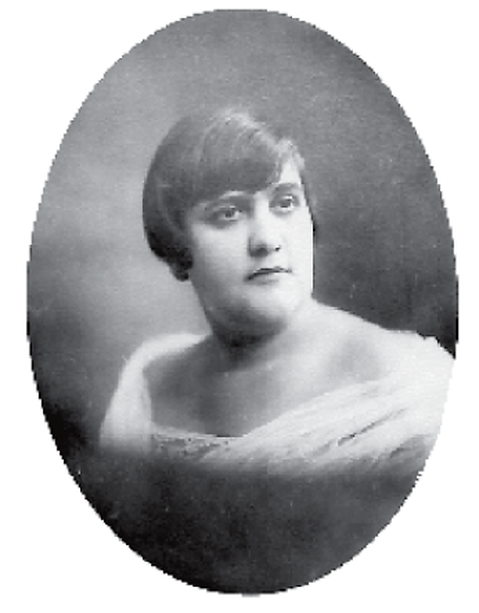After Bulgaria’s liberation, it took its new capital mere decades to be transformed into a modern city with wide streets and splendid buildings. Contacts with European culture, universities, traveling all combined to form a segment of society, people with refined taste and with minds open to the progressive ideas of the old continent. As they opened up to new horizons, people in Sofia were starting to take a closer look at their appearance and would often leaf through fashion magazines from Paris.
By the early 1920s, the so-called French-style tailors (frenketerzii) in Bulgaria’s bigger towns were making clothes after the French fashion, but there was room for only one fashion arbiter in the Kingdom of Bulgaria – Pelagia Vidinska, born in 1896 to the family of a sergeant major. Her studio in Lege Street was the place where the outfits of the ladies of high society were born, among them the Bulgarian Tsaritsa Giovanna of Italy.
 Young Pelagia got her surname from Vidin – the town on the Danube where her father was quartered. Perspicacious and well-off, he sent his daughter to the secondary school in Thessaloniki to glean the best of the system of education and learn the European languages practiced most at the time. And as she was fluent in French and German, Pelagia was able to communicate, on an equal footing, with couture houses that dictated fashion in the European countries.
Young Pelagia got her surname from Vidin – the town on the Danube where her father was quartered. Perspicacious and well-off, he sent his daughter to the secondary school in Thessaloniki to glean the best of the system of education and learn the European languages practiced most at the time. And as she was fluent in French and German, Pelagia was able to communicate, on an equal footing, with couture houses that dictated fashion in the European countries.
“The 1920s and 30s saw the rise of many women designers – in Europe, but also in Bulgaria,” says Elitsa Pavlovic, author of the project “Female enlighteners”. “So that Pelagia Vidinska was part of a much broader movement in fashion, reaching out beyond the borders of Bulgaria. She maintained contacts with Paris and attended fashion reviews in the French capital.I do not know whether she was personally acquainted with the big names in fashion like Coco Chanel or Jeanne Lanvin but she was certainly acquainted with their work.”
There is no information as to what triggered Pelagia Vidinska’s interest in fashion. But it was obvious she possessed a keen sense of style which helped her realize that following Paris fashions blindly in a country on the crossroads between East and West simply cannot work. And because she knew Bulgarian folk costumes so well, one day she just took the embroidery from them and sewed it onto her high fashion outfits.
From the very outset of her career Pelagia Vidinska was in contact with the biggest French couture houses. In an interview for “Fashion Journal” she talks of the success her dresses had in Paris, adding that a foremost French fashion house had commissioned her to make garments with Bulgarian-style embroidery.
Every time she came back from Paris Pelagia Vidinska created a collection with the latest in women’s fashion. She had memorable reviews – like the one at the Sofia “Royal” theatre in 1928. The first part was of outfits and traditional national costumes with names like “Macedonia”, “Blue Ohrid”, “Lovech”, “Bolyarka”, and the second part presented clothes inspired by Paris fashion. But whatever she may have been making, she only used first-class fabrics and strictly watched out for the line of the garment. No wonder then that stars like Mimi Balkanska, the “queen of operetta”, had no hesitation putting their trust in her.
“What sets her apart is her talent, because fashion is a form of art,” Elitsa Pavlovic says. “And as she was well educated in respect of her work this enabled her to create an interesting amalgam of classical low waist dresses and specific jackets on the one hand, and on the other – traditional Bulgarian embroidery and braiding. She also had a nose for business and built her fashion houseall by herself. That in itself is an incredible achievement for a single woman, unable to rely on financial or moral help from a husband – something that mattered very much back then.”
They call Pelagia Vidinska the Bulgarian Coco Chanel – maybe because they both started out in the world of fashion at the same time, were always the epitome of refinement and had impeccable taste. But unlike the designer from France, whose fashion empire prospered, the Bulgarian fashion designer lost literally everything after 1944. Up until the end of her life in 1960 she made a living as a costumer at the National Theatre and was permitted to design the folk costumes of the Philip Koutev folklore ensemble.
The Bulgarian minority in Romania marked a significant event with the official opening of the Bulgarian Inn in the village of Izvoarele (Hanul Bilgarilor), Teleorman County (Southern Romania)- a locality with Bulgarian roots dating back over 200 years...
The 14th edition of DiVino.Taste, Bulgaria’s leading forum for wines and winemakers, will take place from 28 to 30 November at the Inter Expo Centre in Sofia. Over 80 producers from all wine regions will participate, offering tastings of around 600 of the..
Minutes before the second and final reading, at the parliamentary budget and finance committee, of the state budget for 2026, the leader of the biggest party represented in parliament GERB Boyko Borissov halted the procedure and sent the draft bill..

+359 2 9336 661
